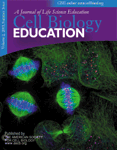The Promise of New Ideas and New Technology for Improving Teaching and Learning
Abstract
There have been enormous advances in our understanding of human learning in the past three decades. There have also been important advances in our understanding of the nature of knowledge and new knowledge creation. These advances, when combined with the explosive development of the Internet and other technologies, permit advances in educational practices at least as important as the invention of the printing press in 1460. We have built on the cognitive learning theory of David Ausubel and various sources of new ideas on epistemology. Our research program has focused on understanding meaningful learning and on developing better methods to achieve such learning and to assess progress in meaningful learning. The concept map tool developed in our program has proved to be highly effective both in promoting meaningful learning and in assessing learning outcomes. Concept mapping strategies are also proving powerful for eliciting, capturing, and archiving knowledge of experts and organizations. New technology for creating concept maps developed at the University of West Florida permits easier and better concept map construction, thus facilitating learning, knowledge capture, and local or distance creation and sharing of structured knowledge, especially when utilized with the Internet. A huge gap exists between what we now know to improve learning and use of knowledge and the practices currently in place in most schools and corporations. There are promising projects in progress that may help to achieve accelerated advances. These include projects in schools at all educational levels, including projects in Colombia, Costa Rica, Italy, Spain, and the United States, and collaborative projects with corporate organizations and distance learning projects. Results to date have been encouraging and suggest that we may be moving from the lag phase of educational innovation to a phase of exponential growth.
INTRODUCTION
In the past three decades, there has been very significant progress in our understanding of how humans learn. An excellent summary of the status of our understanding of learning can be found in a report by the National Academy of Sciences (NAS) of the United States (Bransford et al., 1999). The key learning principle is that each learner must construct his/her own understanding of concepts, relationships, and procedures. While peers and teachers can assist a learner in learning, the construction of meanings and understandings, often together with skills and positive feelings, is fundamentally an idiosyncratic process that only each learner can choose to achieve.
We were fortunate in our research program to have embraced the cognitive learning theory of David Ausubel (1962, 1963, 1968, 1978, 2000) in the early 1960s. The most important idea in Ausubel's theory is that of meaningful learning. Teachers can encourage meaningful learning by using tasks that actively engage the learner in searching for relationships between her/his existing knowledge and the new knowledge and by using assessment strategies that reward meaningful learning.
As with research in any field of inquiry, new studies have often led to the development of new methods for creating educational events and new methods of making observations and recording successful and unsuccessful learning by individuals. For example, our research at Cornell University led to the development of a tool we call concept maps that permit us to observe and record changes in an individual's understandings over time. Figures 1 and 2 show examples of changes in a college biology student's understanding of cells from the beginning to the end of a semester. We see here the enormous development of cognitive structure for this student during the semester. Note that her first map has confused the terms prokaryotic and eukaryotic (the reverse is correct), not uncommon for students who have been learning largely by rote and not building an organized cognitive structure. Also note that she does not relate organs to cells but places these separately, lower in her concept map. Her biology course required regular construction of concept maps and other activities and assessments that emphasized meaningful learning. By the end of the semester, she has built a largely valid, integrated knowledge of cells (Figure 2). The research from which these maps are samples showed that concept maps could be used to study how learners restructure and build their knowledge of biology (Pearsal et al., 1997). There is a large body of research that shows that concept maps can be used to facilitate meaningful learning more effectively than traditional teaching approaches (Novak and Wandersee, 1990; Willerman, 1991; Canas et al., 2003).
Figure 1. A concept map drawn by a college biology student at the beginning of the semester showing misconceptions and limited integration of concepts.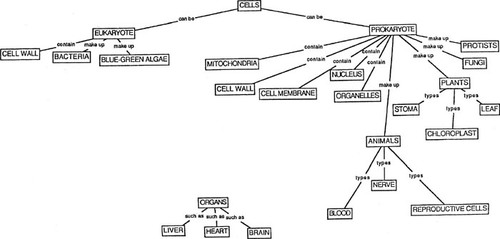
Figure 2. A concept map drawn by the same student as in Figure 1 at the end of the semester. Note the enormous growth of organized knowledge and the remediation of the prokaryote leukaryote concepts.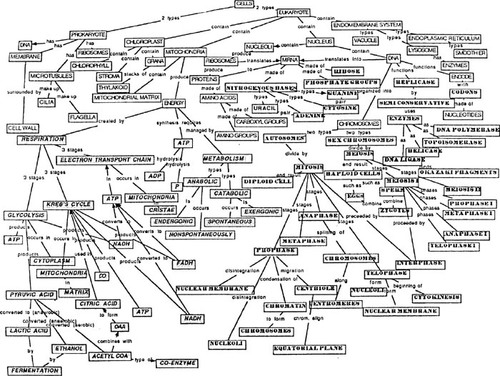
Not only have advances in computer technology brought us enormous capability in processing and storing information, but with the development of the Internet, we now have a tool for disseminating information and knowledge that is much more powerful than that gained by the invention of the printing press in 1460. Who would have imagined that we could provide information on any topic and a forum for exchange of ideas to anyone anywhere at no cost!
While we can expect further progress in our understanding of human learning in the future and further improvements in technologies, the major immediate challenge we face is the proverbial resistance of humans to change their ways of doing things. This paper seeks to explore ways to apply what we have learned and, hopefully, to gain “missionaries” to help disseminate and apply the new ideas and technologies.
ADVANCES IN UNDERSTANDING LEARNING
The most important idea in Ausubel's assimilation theory is the distinction between rote and meaningful learning. Rote learning occurs when the learner makes little or no effort to relate new information to relevant knowledge she/he already possesses or when the learner has little organized relevant knowledge. In contrast, meaningful learning occurs when the learner deliberately seeks to relate and incorporate new information into relevant knowledge structure she/he possesses. Learning can vary on a continuum from extreme rote to highly meaningful, with key factors being the strength of the learner's commitment to learn meaningfully and the quantity and quality of organization of her/his relevant knowledge. However, the teacher can influence the choice to learn meaningfully by the kind and organization of information presented, how it is sequenced, and instructional strategies employed. Also very important is the teacher's choice of evaluation or assessment strategies. The common multiple-choice or true–false test usually encourages rote learning and discourages meaningful learning.
Using concept maps in instruction and in assessment can strongly support and encourage meaningful learning. Other alternative instructional strategies and assessment strategies can encourage meaningful learning and deeper understanding of any subject matter (Mintzes et al., 1998, 2000; Pellegrino et al., 2001). It is not possible for the learner to reach high levels of meaningful learning until some prior relevant knowledge structures are built, and thus learning must be an iterative process over time to build expertise in any domain of knowledge. Rote learning is possible with almost no relevant knowledge, and this is one reason many learners turn to rote learning in our classrooms. Moreover, if the assessment measures require little more than rote, verbatim recall of information, there is neither reward for nor encouragement to learn meaningfully. In fact, because meaningful learning involves assimilation of new information into the learner's existing knowledge structures verbatim recall can be more difficult, whereas application of information for use in new contexts is facilitated.
The ability to apply concepts learned in one context to novel problems requires a deep understanding of concepts. This can be achieved only through high levels of meaningful learning. So why is it, then, that most learners choose to learn by rote most of the time? Two reasons mentioned above are that too often learners have little functional relevant knowledge and too often the school tests require little more than verbatim repetition of information presented. It is also a fact that most learners possess at least some misconceptions or faulty conceptions in virtually every topic we seek to teach (Gonzales et al., 2001; Novak, 2002). We see illustration of this in Figure 1.
If learners attempt to link new information to the faulty ideas they possesses, the result can be more elaboration of these misconceptions and poor performance on both tests of rote recall and tests for novel applications of their knowledge. This ego-assaulting result is probably something we all have experienced at some time in our schooling, when we may have chosen the easier, less painful course of simply memorizing information or problem-solving algorithms without trying to achieve understanding. And usually we have managed to pass instructors' exams partly by our skill in taking simple tests.
A 12-YEAR LONGITUDINAL STUDY OF CHILDREN'S CONCEPT DEVELOPMENT AND THE ORIGIN OF CONCEPT MAPS
One of the controversial issues in the early 1960s was the extent to which children could profit from instruction on abstract, basic science concepts such as the nature of matter and energy. The dominant thinking in science education and developmental psychology was centered on work of Jean Piaget, including his ideas about cognitive operational stages. The fundamental question that concerned me and my research group was, Are these cognitive operational limitations the result of brain development? or Are they at least partly an artifact of the kind of schooling and socialization characteristic of Piaget's subjects and that commonly occurs in the United States and other schools? Ausubel and Piaget shared in common the recognition that each child must construct for himself/herself the mental structures that would lead to proficient adult performance.
The challenge as we saw it in the early 1960s was to design instruction that would present foundational ideas in science with activities and language that would build upon what children bring to school at age 6 and to develop cognitive structures that could facilitate the learning of all science in later years. We recognized that most elementary school teachers were lacking in their understanding of the nature of matter, energy, and energy transformations and therefore we chose to use a strategy that we had developed for teaching college botany called the audiotutorial method (Postlethwait et al., 1964, 1972). In 1965, we began to develop audiotutorial lessons that would provide children with audiotaped guidance in observation and manipulation of materials, photos, 8-mm loop films, and various kinds of apparatus. Figure 3 shows an example of one audiotutorial lesson set up in a carrel unit in a first-grade classroom.
Figure 3. A 6-year old student in an early audio tutorial carrel working with apparatus to study plant growth.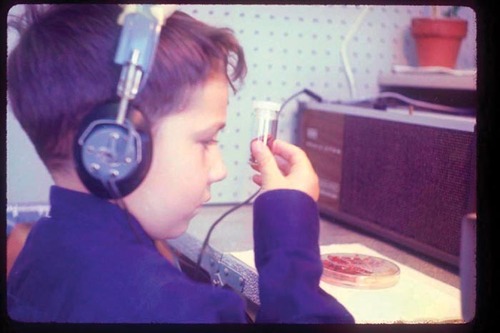
We began a study of the long-term effect of early instruction on basic science concepts in 1971, utilizing 28 of our best audiotutorial lessons, each requiring about 20 min of study and interaction. The objective was to follow these 191 students throughout their school tenure, interviewing them periodically on their understanding of the basic science concepts as evidenced through interpretation of things that were common to their experiences. We also began interviewing 48 students in the same classrooms (and with the same teachers) who did not receive audiotutorial instruction in 1972. We soon found that we were being overwhelmed with interview tapes and transcripts and that it was difficult to ascertain from the tapes or transcription specific changes in children's understanding of science concepts. Turning to our foundations in Ausubel's learning theory, our research group came up with the idea of representing knowledge revealed by the interviews as concept maps, with concepts and propositions organized into a hierarchy, with the most general, most inclusive concepts at the top and the more specific, less inclusive concepts lower in the hierarchy. We found that a 15- to 20-page interview transcript could be represented in a 1-page concept map, such as the one shown in Figure 4. Moreover, reviewing the concept map with the child interviewed indicated that we indeed had captured key elements of her cognitive structure that was guiding the formulation of answers to our questions. Thus was born the incredibly powerful tool, the concept map, and over the years we have found increasing applications for this tool, especially with the advent of computer software to construct and enhance concept maps.
Interviewing and concept mapping student's understandings over a 12-year period, we observed enormous gains in conceptual understanding for some children and little or no gains for some other children. However, we observed large gains for more children who had the carefully designed audiotutorial science instruction in grades 1 and 2, and then standard school instruction, but not for those who persisted in rote learning. The remarkable result was that this early instruction influenced their learning throughout their school tenure, and these students strongly outperformed similar students who did not have this early instruction (Novak and Musonda, 1991). Figure 5 shows the very significant differences in valid and invalid ideas held by students. The persistence of high levels of invalid ideas for the students who did not have the early science lessons suggests that most of these students persisted in essentially rote learning information dealing with the nature of matter and energy in subsequent science courses. We found that we could use the concept map tool to show precisely how the children's knowledge structures were changing over time. Subsequently we have found many uses for concept maps, including helping people “learn how to learn” (Novak and Gowin, 1984).
Figure 4. A concept map prepared from an interview with a 7-year-old student. Note that although Paul has learned some key ideas about the nature of matter, they are not well organized or well integrated. Paul had not received audiotutorial lessons.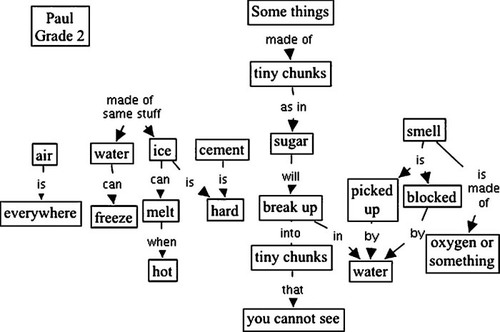
THE ROLE OF NEW TECHNOLOGY
Impressive as our advances in understanding learning have been over the last few decades, even more striking advances have occurred in technologies useful in educating in just the past decade. Foremost among these has been the development of the Internet and high-speed transmission of information, along with exponential growth in computing power. These advances have been so rapid that educational systems are, in general, far behind in exploiting the potentials that are offered. Part of the difficulty in utilizing new technology is the cost of new hardware and software. While computer power has increased dramatically, and a peso, lira, or dollar buys much more, the costs are still substantial. Added to this, the cost for Internet access for all students is an additional burden to schools and families. Some software is expensive, but there is much excellent software available at little or no cost, especially for schools. As costs continue to decline, and more and better materials are available, we can substitute electronic documents for most textbooks, and this can lead to total costs for instructional materials that begin to decline over time. Of course, books will always have a role to play, and few of us prefer reading screens to printed copy.
Figure 5. Differences in valid and invalid and invalid notions about the nature of matter and energy held by audiotutorial-instructed students (black bars) compared with students who did not receive audiotutorial instruction in grades 1 and 2 (light bars).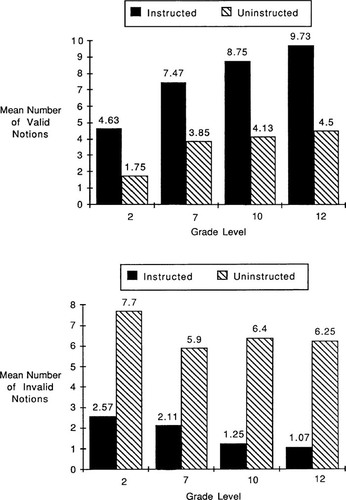
One of the most useful software tools available is CMap, developed at the Institute for Human and Machine Cognition (IHMC) at the University of West Florida. This software can be downloaded at no cost for school use at www.coginst.uwf.edu. Although there are a number of software programs that can be used to make concept maps, CMap has been explicitly designed to make concept mapping easy. CMap also provides some special features such as the ability to organize discussion groups, locally or at a distance, using the Internet, attachment of icons to concepts that can access pictures, videos, URLs, other concept maps, or any other resources that can be digitally stored in a local or remote computer or server. Figure 6 shows an example of such a concept map, developed by Geoff Briggs at NASA, with a sample of two resources that were added through the icons. The entire set of MARS CMaps can be downloaded at the IHMC Web site or at http://cmex.arc.nasa.gov NASA is one of the governmental units now using concept maps to capture and archive valuable expert knowledge.
USING CONCEPT MAPS AND THE INTERNET AS A BACKBONE FOR INSTRUCTION
One of the problems with the use of textbooks is that they provide only one pathway through a given knowledge domain. Often this pathway may make sense to the writer, but it can never be the optimal pathway for all learners in any group. The same can be said for a lecture series. Given our knowledge that every learner has a unique cognitive structure, derived from a unique sequence of cognitive, affective, and action experiences, it is obvious that the fixed sequence of learning events scheduled by a text or syllabus is going to be less than optimal for all learners. The challenge we face is how to accommodate for these individual differences and still move a group forward toward understanding of fundamental ideas in whatever field of study concerns us.
Using CMap software, instructional mediation can be based on an expert's knowledge as shown in a simple concept map providing a kind of“ conceptual scaffolding” that can serve as a starting point for a learner. Then the learners progress in their own idiosyncratic way to build their knowledge structures and represent them as a more complex, more elaborated maps. Early studies by Vygotsky (1934, 1972) showed that learners progress best at their “zone of proximal development” (ZPD). That is, new concepts and propositions can be best learned when they build upon and advance the understanding of related prior concepts held by the learner. Moreover, cognitive development is enhanced by social interaction with peers who are at approximately the same ZPG. This would be favored in small group dialogue as collaborating students work to build and elaborate a concept map.
Figure 7 shows an example of an expert's map dealing with plants. Added to this figure by a cooperating group of students are some resources that can be accessed by clicking on the icons on the plant CMap. The added resources shown are a submap on bees (also with added resources), a photo of a flower, a time-lapse video clip of a flower opening (accessed through a URL), a photo of a bee on a flower, a germinating seed, and a text box explaining leaf coloration. Using IHMC's CMap 3.0 software, resources can be added simply by dragging the icon for a resource or a URL onto the concept where it is “attached.” Shown in Figure 7 are only some of the resources that have been added and can be accessed by clicking on icons on these concept maps. Thus we see that the students have created a veritable portfolio of materials dealing with plants. Furthermore, CMap software allows the map construction to proceed either synchronously, with the collaborators being online at the same time, or asynchronously, with the collaborators working at different times. This kind of collaboration, within a classroom, across schools, or across nations, can have both cultural value as well as contribute to better understanding of concepts by all participants due in part to the varying insights different groups bring to the process.
It would be a very boring classroom where students did nothing but add to expert's concept maps and assemble resources from the Internet. We also expect that students would engage in field and laboratory studies, and data from these studies could be incorporated into their concept maps. There are exciting laboratory and field study suggestions on the Internet for almost any topic of study, as well as suggestions for gathering local resources for use in hands-on studies (see, for example, http://www.dlese.org or http://nsdl.org/render.userLayoutRootNode.uP).
Figure 6. A concept map prepared by a NASA scientist to illustrate key ideas about the nature of Mars and examples of two resources that can be accessed by clicking on icons on the map.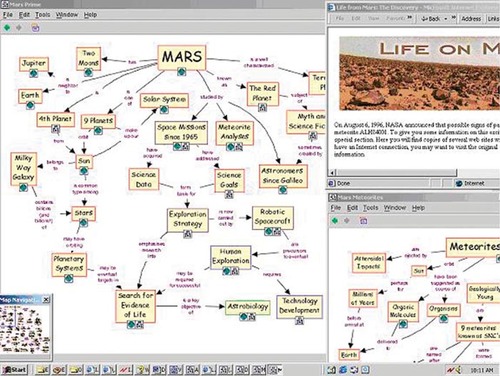
Learners can raise questions, answer questions, and comment on answers offered by other students in the “discussion threads” made possible by the software. Also, not shown are graphs, tables, or charts that might be constructed by a class or other groups of learners in showing, for example, rate of plant growth under increasing temperatures, and chromatographs of leaf and flower pigments. Teachers continue to play an important role in guiding the inquiry and organization of knowledge into various representation forms, as well as providing feedback and assessment of learner's successes. Of course, such open pursuit of knowledge using the vast resources of the Internet may soon surpass any teacher's knowledge on any given topic, but the teachers can learn along with the students, increasing their knowledge and competence, as well as providing opportunities for them to manifest their excitement in new learning. In elementary schools, where teachers seldom have deep conceptual knowledge of all the disciplines that might appropriately be studied, the learning opportunities afforded by building on expert “scaffold” concept maps can be far beyond anything we see in schools today. This may be especially true in sciences and mathematics, where most elementary teachers are poorly prepared and where students are highly interested in and very capable of achieving substantial levels of understanding, as shown in our 12-year study.
THE PROBLEM OF ASSESSMENT
Beginning in the elementary school, assessment begins to be the plague of both teachers and students. It is not easy to assess how a young mind is grasping new meanings and skills, especially in the traditional classroom setting. The result is that much of school assessment captures little more than the student's acquisition of facts, problem-solving algorithms, and concept definitions, with little attention to whether or how they are building powerful knowledge structures. This is clearly the case with most state and national assessment programs that are now so popular with politicians in the United States. With regard to skills, assessment of reading and reading comprehension, speaking, or quantitative representations is often limited, at best, or even ignored. What I and many of my colleagues interested in fostering meaningful learning have observed in recent years is that teachers are so obsessed with “looking good” on state and national tests that they spend so much of their time reviewing old exams and coaching for taking exams that other activities are squeezed out of the schedule. This occurs even though our research and the research of others have shown that if students learn for understanding, they will do as well or better on typical“ achievement tests” as if they focus on preparation for exams. Moreover, the students who are learning for understanding will do much better when they are asked to transfer their knowledge to novel problem-solving situations (Basconas and Novak, 1983; Novak et al., 1983). Over a span of years, students whose teachers emphasize preparation for exams become skillful at playing the school game and may score high marks with little or no understanding of most disciplines. DiSessa (2001) observed,
Figure 7. An “expert” concept map used to “scaffold” student learning, prepared by a collaborative team adding concepts and resources dealing with plants. The insets show some of the resources accessed by clicking on icons and a sample text comment.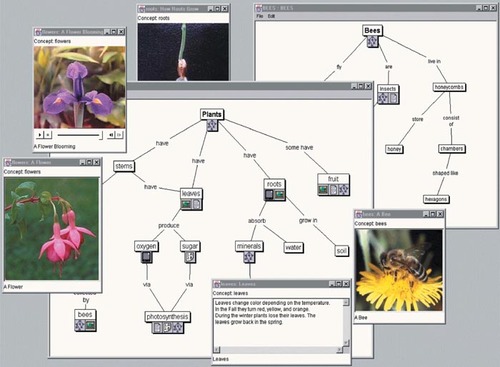
The most disturbing thing I uncovered in a study of bright, motivated, successful MIT undergraduates years ago was that, although they did very well in high school physics, got high marks, almost none felt they really understood the material. (p. 107)
His observations could be applied to virtually every area of school studies in high schools and university. For example, the Harvard Private Universe Project (Schneps, 1989–1995) found that 21 of 23 Harvard graduates, alumni, and professors interviewed could not give a satisfactory explanation of“ Why do we have seasons?” including a graduate who had recently completed a course in the Physics of Planetary Motion. And yet, only 10 concepts, properly organized in cognitive structure, are necessary for understanding why we have seasons. Of course, if we were to include the wet and dry seasons commonly seen in tropical climates, a few more concepts and propositions would need to be assimilated into the structure. Similarly, most MIT graduates, faculty, and alumni interviewed could not explain where the weight of a log came from.
It is easy to underestimate the tenacity with which learners will persist in rote-mode or near rote-mode learning strategies. After all, these have most often led to success in school assessments, and they often require less mental work than seeking to understand the material that is being presented. The assessment problem is enormously difficult because there are no easy solutions. Concept maps used in instruction can also be used subsequently as powerful assessment tools, as indicators of student understandings or faulty understandings. However, introducing concept maps into instruction is not easy for teachers or most students. The whole educational system in the United States and most other countries makes the transformation difficult, as Kinchin (2001) has observed. Portfolios, written works, and other assessment tools can be used, but all of these put greater demands on the teacher and students than the ubiquitous multiple-choice tests. Nevertheless, strategies for using and“ scoring” other forms of assessment are being developed and some assistance from computer-aided assessment is likely in the future (Mintzes et al., 2000; Pellegrino et al., 2001).
There is also the difficulty of dealing with the affective or emotional dimensions of learners, especially if they feel threatened by the subject matter. When students feel they cannot understand a subject, their best ego defense is to stay with strategies that have been successful for them in the past. Rote-mode learners get trapped into a cycle of memorizing whatever they can and hoping this will be sufficient to pass, thus failing to build the knowledge structures that could permit them more easily to learn meaningfully and gain in confidence and success in future learning and novel problem solving. The affective support needed can often be best provided in collaborative teams, especially when the teams have clear goals and the time and the opportunity provided for meaningful learning, such as proposed above in the use of expert “scaffolding” with concept maps and other technology. At the University of Rochester, a number of science courses are using student tutors with small groups in the solution of problems. Part of the training program for the tutors includes building sensitivity to student ego needs as well as guiding their work on the problems. The approach has been shown to result in superior achievement, as well as more positive attitudes toward the subject (Tien et al., 2002).
One effective strategy that may be employed is to have students construct“ digital portfolios” using CMap software that allows for incorporations into a coherent knowledge structure of almost any kind of resource that can be manipulated digitally. Other instructional strategies are also effective for achieving student understanding of the subjects they study (Mintzes et al., 1998). In the past decade, we have seen a growing interest in the interplay between students' cognitive development and their psychomotor and affective development (Edmondson and Novak, 1993). The bottom line in all of this for education as I see it in my theory of education is this: “Meaningful learning underlies the constructive integration of thinking, feeling, and acting leading to empowerment for commitment and responsibility” (Novak, 1998, p. 15).
A LOOK TO THE FUTURE
The traditional classroom is likely to be with us for many years to come. However, there are good reasons why we shall see increased use of electronic tools in terms of both cost and educative value. For example, in the relatively poor country of Colombia, the mayor of Medellin is pursuing a program to provide high-end computers and high-speed Internet connections for every student in the city. Extensive use of CMap software and“ expert” concept maps to scaffold student learning is planned in Medellin. The exponential growth in distance-learning opportunities utilizing electronic tools also illustrates this trend, even though many of the current distance-learning programs are hardly more than the talking face of the instructor with a few additions. In due course, the better distance-learning programs will also influence instruction in the classrooms. We envision a better mix of personal contact between students and the teacher, and also between students, in a decade or two, as all instruction becomes increasingly involved with the use of the Internet and other electronic resources. A successful implementation of computer-assisted collaboration among students within and between classrooms, including classrooms in different countries, has already been achieved (Canas et al., 2001).
The U.S. Navy is currently exploring with IHMC ways that concept maps can be used both as instructional training tools and as tools to capture, preserve, and better utilize the expertise of senior personnel about to retire. They also see the opportunities that concept maps, used with the Internet, CDs, and other resources, can bring for providing“ just-in-time” training for sailors on ships distributed all over the world.
Another promising example of the use of the Internet and other electronic resources is Project LINCOS, now under way in Costa Rica, the Dominican Republic, Guatemala, and Nicaragua and planned for other countries ( www.lincos.net). With the primary resources housed in standard ocean shipping containers 8× 20 ft in area, these units are bringing the world to remote communities in developing countries. Figure 8 shows the setup for one of these units, including the use of Internet for accessing information via a satellite dish. These units can be entirely self-contained and brought into communities without telephone lines or even electricity. They are providing new employment opportunities to people in the villages where they are installed, and some of these communities are selling local products using their own Web site for promotions. Figure 9 shows elementary school students working on computers in a LINCOS unit. Senior citizens in these communities are learning to use the Internet to communicate with children and relatives anywhere in the world. The LINCOS project not only has high educational potential, but also is helping communities to work more collaboratively across age groups and in diverse applications, including better political communications.
Figure 8. A LINCOS unit set up in rural Costa Rica to provide computer resources and Internet access to students and adults in the community.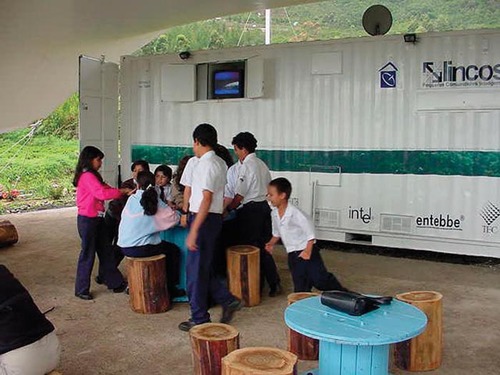
Figure 9. Elementary school students working on the Internet in a LINCOS unit shown in Figure 8.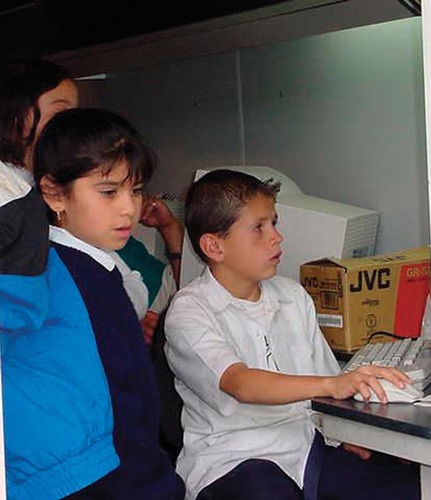
Another project we are currently working on is to have experts in sciences prepare 300–400 concept maps for essentially every domain of science, including “global” maps of the type shown in Figure 10. These concept maps would be used as illustrated above for the Plants concept map. At this writing it appears likely that we will get the funding needed to implement this project in developing countries and the United States. We expect this will provide significant impetus for change in instructional practices as individuals and schools move to utilize these resources fully, together with CMap software and Internet resources. The cognitive scaffolding these maps could provide in sciences could serve to illustrate how similar maps prepared by experts might be used in every discipline. Imagine the opportunities this could open up for the 2 million parents now doing home schooling. Once these programs are implemented, there will be some excellent research opportunities to assess the successes and shortcomings of the program and distribution methods and ways to improve them.
Figure 10. A sample of the type of “global” concept map that we plan to provide to “scaffold” student or adult learning at home or in school.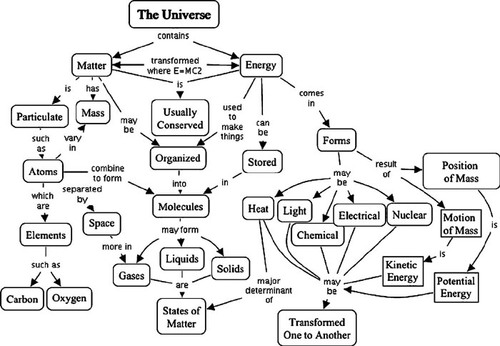
Though we cannot do the latter research until the “concept map scaffolding” project is implemented, at least on a pilot basis, there are research studies suggesting that the results can be very promising. For example, a study done in Maracay, Venezuela, with high-school physics students showed that students preparing concept maps in their studies far outperformed, by about two times, their classmates who used only conventional text problems and questions for preparation throughout a school year (Basconas and Novak, 1985). We also administered a popular intelligence test to all students and compared achievement for high-, middle-, and lowability groups. As shown in Figure 11, we found that ability, as measured, had no significant influence on achievement, and even lower-ability students in the concept mapping classes surpassed the achievement of high-ability students in nonmapping classes. Moreover, looking at the trend lines drawn using the high-ability mean scores for both groups, we see that the concept mapping students continue to improve over the eight study units of the school year, whereas nonmapping students improve their performance somewhat but then “level off” in their scores. These results are what we would expect if concept mapping encourages meaningful learning and thus building students' knowledge structures, whereas most nonmapping students continue to learn largely by rote. The data were even sufficiently sensitive to the latter effect that we see a dip in mean scores for the mapping students for unit 4 but no such dip for nonmapping students. Since the curriculum moves from the early, closely related studies of forces and kinematics in units 1–3 to the study of electricity and other wave-related work in unit 4, the results are exactly what the assimilation theory of learning would predict. As students built their conceptual structure dealing with forces, motion, and kinematics, their problem-solving success improved. When they moved into a new conceptual domain, they needed to build up relevant cognitive structures in this domain. This study and many others clearly support our optimism for the science concept map scaffolding project (see Novak and Wandersee, 1990).
Figure 11. Mean problem-solving test scores for concept mapping and nonmapping high school physics students, shown by low-, middle-, and high-ability groups, for eight study units during the school year. Also shown are trend lines (Poly) drawn using the means for the high-ability concept-mapping (upper line) and traditional (lower line) students.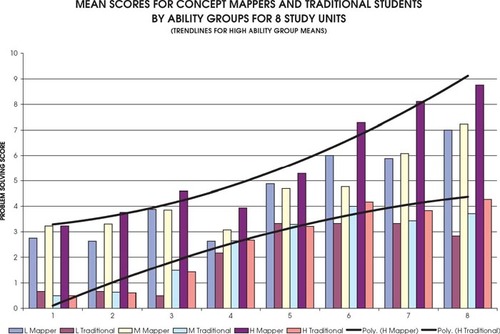
CONCLUSION
Perhaps for the first time in the history of education, we have the opportunity to make a quantum jump improvement in education, or at least I believe so. Admittedly, there is much to be learned in melding new technology with our growing understanding of human learning and the structure of knowledge. Nevertheless, I believe that the foundations have been laid, and I expect an accelerating rate of progress in moving instruction from students“ swimming in a sea of meaninglessness” to education where the learners are active participants in constructing and reconstructing more and more powerful cognitive, affective, and psychomotor frameworks.
Corporations are also recognizing that there are new and better ways to educate (not train) their workers to organize, share, and utilize their knowledge and significantly enhance the creativity of individuals and the corporation (Fraser and Novak, 1998; Novak, 1998). I have seen some of the ideas presented here work very successfully at Procter and Gamble, at Kodak, and, more recently, with the consortium, Electric Power Research Institute (EPRI). Corporate leadership has long recognized the necessity for building on new basic science ideas and technological knowledge from the sciences and some other fields, but they are only beginning to recognize the distinction between training and educating and the power and relevance of the tools and ideas presented here. EPRI is currently engaged with IHMC in a project to use concept maps to capture expert knowledge and to seek alternatives to utilize their knowledge assets better. While education is a significant portion of the budgets of any nation, the funds are relatively small compared with the huge resources that can be generated from better utilization of knowledge in corporations and governmental groups. I would predict that within the next decade we shall see new kinds of partnerships forming among educational institutions, corporations, and governments.
The challenge is clear: we need to expand vastly our efforts to disseminate the new educational ideas and tools and we need more and more vigorous leadership from the educational community. This is the challenge that I extend to you.
FOOTNOTES
Monitoring Editor: Gordon Uno
Note. An earlier version of this article was presented in Urbino and Milan, Italy, in September 2002.


